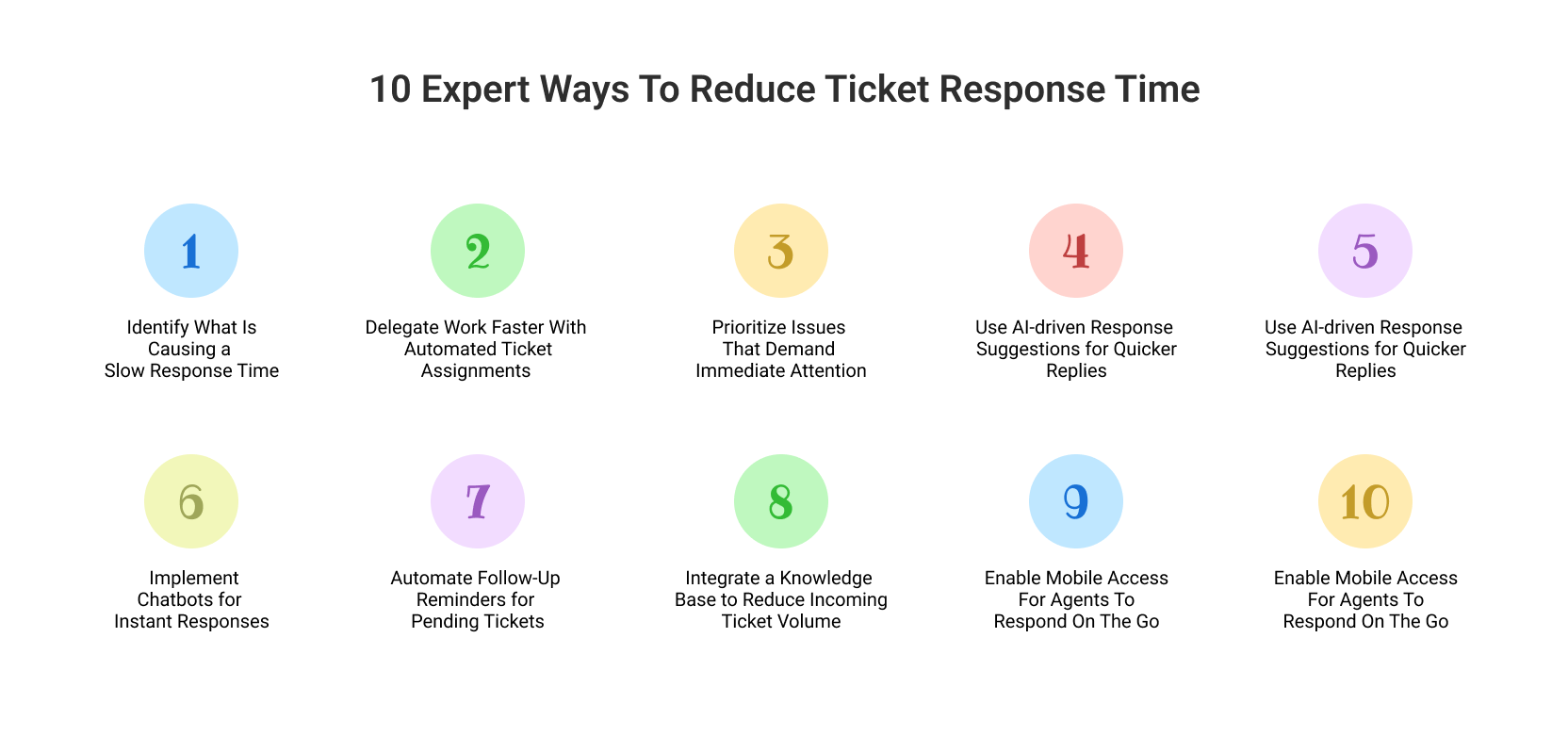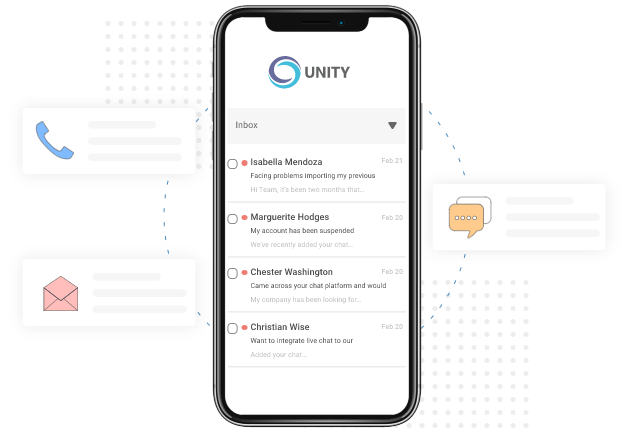Advancements in automation capabilities have created a new consumer breed: the “NOW” customer—the ones who demand instant solutions to their problems.
Even a slight delay in ticket response time can turn a minor inconvenience into a major frustration, leading to customer churn and negative reviews.
If your business is struggling with lengthy ticket response times, it’s time to take action.
In this blog post, we’ll unveil 10 expert strategies to help you streamline your support process. Whether you’re dealing with overwhelming ticket volumes or a lack of resources, these actionable insights will empower your team to deliver lightning-fast responses and boost customer satisfaction.
What Is Ticket Response Time?
Ticket Response Time refers to the amount of time taken by a support agent or team to respond to a customer or user after a support ticket is raised. This metric is crucial in customer service and help desk environments as it directly impacts customer satisfaction.
There are generally two types of response times:
- First Response Time (FRT): The time it takes for the support team to send an initial acknowledgment or reply to the user’s query.
- Subsequent Response Time: The time between follow-up responses when a conversation requires multiple back-and-forth interactions.
What Is a Good Customer Response Time?
A shorter response time often results in higher customer satisfaction, as it demonstrates that the user’s concern is being addressed promptly.
A good customer response time varies depending on the industry and the type of support channel (live chat, email, social media, etc.), but general benchmarks are as follows:
Live Chat:
Under 1 minute
Customers expect immediate assistance on live chat, with many expecting a reply within 30 seconds to 1 minute.
Email:
Within 1-4 hours
While email allows for longer response times compared to live chat, a response within a few hours is seen as good, with 24 hours often being the acceptable maximum.
Social Media:
Within 1 hour
Social media inquiries are typically public, so faster response times (within an hour) help manage public perception and customer expectations.
Phone Support:
Under 1-2 minutes (hold time)
Customers expect minimal hold times when calling for support, so answering within 2 minutes or less is preferred.
10 Expert Ways to Reduce Ticket Response Time
Do your customers complain about slow and sluggish service? Here are 10 actionable tips to gear up your team for fast response times:

1. Identify What Is Causing a Slow Response Time
A slow customer service response time can be a slow poison for your business. If your team consistently misses response SLAs, it’s time to wear your detective hat.
You must conduct a root cause analysis to understand why your customer service team takes longer than usual to respond to customers.
Here are some questions you can address:
- Which customer service agents typically take more time to respond?
- Are we paying adequate attention to high-priority issues?
- Which customer service channels are the worst affected?
- What time of the day do we respond the slowest?
- What automation technologies can we implement to improve response time?
You might not be able to find the answers to these important questions in a single day. However, after enough research, you will be able to understand the underlying causes of a slow ticket response time. Once you have identified the causes, work on them, and motivate your agents to enhance the customer experience.
2. Delegate Work Faster With Automated Ticket Assignments
Whenever a ticket lands in your help desk inbox, it should be assigned to the right agent as soon as possible. Failing to do so can lead to confusion and hamper the customer experience.
When agents have to pick tickets for themselves manually, it can lead to unfair distribution of work. Most agents would be eager to pick up easier tickets to meet their daily targets quickly.
However, as a brilliant alternative, you can assign incoming support tickets automatically. Most help desk systems use the round-robin method to distribute tickets among available agents.
This will ensure faster ticketing, equal distribution of work, and less back-and-forth between agents. You can even hold the respective agent accountable if the response gets delayed.
3. Prioritize Issues That Demand Immediate Attention
Let’s say you receive 50 customer issues daily on average. Now, if agents don’t know which tickets to focus on first, it can put your business in a detrimental position.
Ticket prioritization allows agents to organize their work better, shift their focus to critical issues, and keep customers updated about ticket progress.
Depending on an issue’s impact on your business, agents can accordingly mark their priorities (Low, Normal, or High). For example, if a customer complains that their account has been compromised or money has been deducted without their knowledge, it must be marked a high-priority ticket.
Ticket prioritization will surely help your agents plan their work better so that not a single high-priority issue is neglected.
4. Use AI-driven Response Suggestions for Quicker Replies
AI help desk software can analyze the content of customer tickets, automatically providing agents with relevant information and suggested replies.
Using AI-driven response suggestions can significantly reduce the time agents spend crafting responses, allowing them to simply review and send messages with minimal effort. This results in faster response times, especially for common or repetitive issues.
In addition to improving speed, AI-driven response suggestions help maintain the tone and professionalism of responses. By recommending replies that match the brand’s voice and tone, these tools ensure that customers receive coherent, well-structured messages that meet their expectations.
Read More: AI in Customer Service: 10 Ways to Use (& Examples)
5. Implement Chatbots for Instant Responses
AI-powered chatbots are designed to handle frequently asked questions, such as order status, account details, or troubleshooting steps. According to research, chatbots can reduce routine question response times by as much as 80%.
Although their adoption is still growing, chatbots are becoming a common part of many websites, help centers, and social media platforms.
So if you are looking to add a customer support chatbot to your website, there is no better time than now. With bots, you can offer 24/7 assistance, engage customers with human-like conversations, and reduce your response times significantly.
Read More: 10 Chatbot Best Practices for a Business
6. Automate Follow-Up Reminders for Pending Tickets
“Hey Jake, Ticket #SN2375 is pending and deserves your attention.”
By setting up automated follow-up reminders and alerts, support agents are reminded to check on unresolved tickets. This reduces the likelihood of delays caused by oversight or a heavy workload.
These follow-up reminders work by triggering at pre-set intervals (for example, 2 hours after ticket creation), ensuring that pending tickets are addressed before they escalate into larger issues.
Additionally, automating reminders not only improves internal efficiency but also enhances the customer experience. When follow-ups are consistent, customers feel valued and assured that their concerns are being actively managed, leading to higher satisfaction and a more streamlined support process.
7. Integrate a Knowledge Base to Reduce Incoming Ticket Volume
An online knowledge base is another great way to reduce help desk ticket response time. According to Harvard Business Review, around 81% of people attempt to resolve issues on their own before reaching out to a support team.
With a dedicated knowledge base, you can empower customers to resolve basic queries at their own pace. They can find solutions in FAQ pages, guides, video tutorials, and other content.
Your team members no longer need to type answers to routine questions related to product return policies, subscription terms and conditions, etc. Instead, they can share relevant links to self-service articles and quickly resolve the ticket.
Read More: How to Reduce Support Ticket Volume in 15 Sure-Fire Ways
8. Enable Mobile Access For Agents To Respond On The Go

Enabling mobile access allows agents to manage and respond to tickets from anywhere, at any time. With the flexibility of a mobile device, agents can quickly review and reply to customer inquiries during breaks, commutes, or when working remotely, ensuring that no ticket goes unattended for too long.
Mobile access also empowers agents to stay connected and engaged, even during after-hours or emergencies. They can receive real-time notifications about new tickets or updates and act promptly to address urgent issues.
Additionally, mobile access enhances agent productivity by allowing them to work seamlessly across different devices without being tied to a traditional office setup. Whether using a smartphone or tablet, agents can quickly respond to simple queries or assign more complex tickets to the appropriate team, ensuring faster ticket resolution.
9. Hire More Service Agents If Needed
Are you facing an employee crunch? Are agents unable to deal with an influx of support tickets despite all the automation in practice? Well, you might have to hire more people.
Hiring more customer service agents might seem like the obvious solution, but many businesses don’t consider this option due to the additional costs and training.
When you have tried almost everything—building a knowledge base, deploying a chatbot, and implementing all automation features—a heap of unattended tickets simply means you are short on staff.
If hiring full-time employees is not on your roadmap, you can look to hire part-time professionals. They can ease the pressure on your existing team and help drastically improve your response times.
Read More: Top 17 Customer Service Skills to Delight Customers
10. Track & Analyze Response Time Metrics

To improve your ticket response time, you need to measure it first. A great start would be to monitor your team’s average first response time.
AFRT (average first response time) refers to the average time it takes for your customer service agents to share a response to a customer query or issue.
Now, you might wonder what a good first response time is. Well, that can depend on your business or the number of customers you have to deal with. However, as a general rule of thumb, the ideal FRT for live chat can be 1 minute or less. Similarly, for email, it can be 4-6 hours or less.
Consistent monitoring of this metric will help support managers evaluate performance and identify improvement opportunities. If you find out that the FRT has increased in a month, you can try to understand whether the reason lies in training gaps or something else.
Accelerate Response Times & Elevate Customer Satisfaction
When you improve response time to customer requests, you establish trust, prevent customer churn, and create a great impression on your customers.
Now, it’s also important to remember that speedy customer service is not necessarily good customer service. While speed and accuracy are important factors, you must encourage your team to focus on quality, too. There is no point in quickly sharing the wrong solution with a customer to meet your SLA targets.
With AI-powered help desk software like ProProfs Help Desk, you can speed up your customer service process. You can automatically assign tickets to agents, leverage AI responses for faster issue resolution, deploy chatbots on key web pages, and monitor your average ticket response time to enhance the customer experience.
Frequently Asked Questions
Which is the best software to help with ticket responding?
ProProfs Help Desk is considered one of the best tools for ticket responding due to its powerful AI automation features, omnichannel support, user-friendly interface, and forever-free pricing. It helps streamline ticket management, ensuring quicker responses and improved customer satisfaction.
Example of support ticket response time & resolution time
A typical support ticket response time might be 1-2 hours for the first response, while resolution time can range from a few hours to several days, depending on the complexity of the issue. For example, a simple billing inquiry may be resolved in 2-4 hours, whereas a technical bug might take up to 48 hours.
FREE. All Features. FOREVER!
Try our Forever FREE account with all premium features!

 We'd love your feedback!
We'd love your feedback! Thanks for your feedback!
Thanks for your feedback!






